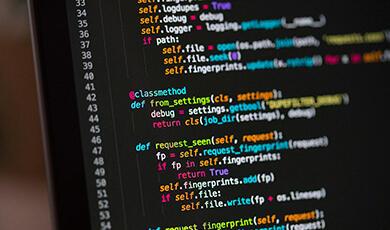The Next Fifty Years of Tech
Share
- Details
- Text
- Audio
- Downloads
- Extra Reading
Come take a ride in the Tech Time Machine and explore how IT may change our lives in the next fifty years. By employing techniques used by science fiction writers, we can imagine how Artificial Intelligence, extended reality, mobile connectivity, quantum computing, and others will develop.
How will they converge, enable and accelerate each other? We can anticipate the opportunities and challenges technology may bring. Why should we fear disruption? Should we instead embrace it?
Download Text
The Next Fifty Years of Tech
Dr Victoria Baines, IT Livery Company Professor of IT
7 May 2024
“It is difficult to make predictions, especially about the future.” This witty aphorism is variously attributed to Albert Einstein, Niels Bohr, or Yogi Berra (amongst others). It is an expression of uncertainty that also implies that predictions should be 100% accurate in order to be useful, and that failure to anticipate the unexpected makes any attempt to consider the future futile. In short, the world is a volatile and uncertain place where global shocks are common.
And yet, we can chart scientific and technological progress better than ever before. Indeed, phenomena such as the weather are now much more intelligible and predictable thanks to Information Technology (IT). Increasingly, we also have access to databases of information on technologies that are in development. With specialist input, we can evaluate (or at least speculate upon) the prospects of whether – and perhaps even when – they may come into mainstream usage.
In a world where IT can come to market so rapidly, we need to be able to anticipate how it may be used and misused. When I was working in law enforcement, I found that criminals made use of most new tech as soon as it became available to them. The logical step was therefore to try and anticipate what they would exploit next, to scan the horizon for tech that was currently in development and about to be released. I began to analyse patents, review published academic papers, and follow media coverage to ascertain what people were working on. As I did, it quickly became clear to me that IT doesn’t develop in a vacuum. It interacts with and impacts upon its environment and other technologies. It wouldn’t be enough to simply consider ‘the future of social media’ or ‘the future of Artificial Intelligence’ in isolation. I would need to build a model in which I could describe those interactions and impacts. I would need to build scenarios for possible futures. And in order to do that, I would need to enter the world of ‘futures thinking’.[1]
A Brief History of the Future
‘Futures thinking’, also known as foresight, is simply the formalised practice of giving due consideration to inevitable change. While some academic researchers locate its origins in ritual attempts to foresee coming events such as divination and astrology, the modern discipline grew in the mid-20th century out of the need, particularly in public policy and business environments, to anticipate changes in the wider world that could impact on an organization’s operations, efficiency, profits, and the like. With the Cold War as its backdrop, it is no coincidence that futures thinking as a planning tool was first popularized in military departments (RAND) and large corporations (Shell International). The futurists of the 1960s tended to take the year 2000 as their horizon. In 1967, Herman Kahn’s and Anthony J. Wiener’s best-selling book of that name presented “a framework for speculation on the next thirty-three years”.
Scenario building has been used by international organisations and corporations for the last fifty years or so. Rather than making linear predictions, it involves imagining a world in which certain features are plausibly present, then considering their impact on society and how they might interact. An imaginative exercise like this has the advantage of uncovering issues we might have missed if we’d considered technologies in isolation. It's also a lot more fun, both for the people doing it and those reading it. But it wouldn’t be robust enough if it were just the product of my imagination. The scientific basis lies in systematic review of information on technological development, coupled with validation of the time frames in the scenarios with industry and other experts. For instance, if I wanted to consider whether it was reasonable to expect that by 2030 we would print our own food and prescription drugs at home – as I indeed did for one such exercise – I could ask experts what they thought by means of a consensus-based survey (Delphi technique). Some tech futures projects, such as the Pew Research Center’s Future of the Internet, do exactly that.[2]
In a parallel evolution, fiction writers also turned their attention to the future and alternative worlds. Influenced by the fantasy writers of Ancient Greece and Rome, the development of science fiction at the hands of Jules Verne and H. G. Wells in the 19th and early 20th centuries, and a plethora of future-oriented novels, movies, and TV shows in the late 20th and early 21st centuries, we have, to some degree, all become futures thinkers. The technology press is full of predictions that science fiction writers “got right”, including the use of debit cards (Edward Bellamy) and video chat (E. M. Forster). More often than not, the architects of our tech future are science fiction fans. When we hear that electronic tablets are rumoured to have been inspired by props in Stanley Kubrick’s 2001: A Space Odyssey, when a national telecoms provider assumes the name of the rogue artificial intelligence in the Terminator franchise (Skynet, Belgium), when a meal replacement drink appears to pay homage to a cannibalistic dystopia (Soylent), when Tesla’s Cybertruck is reported to have been inspired by the flying cars in Blade Runner, and when the word now regularly used to describe immersive environments has been lifted directly from Neal Stephenson’s Snow Crash (metaverse), it is clear that our collective imagination is directly shaping the future.
Futures thinking today is a combination of forecasting based on (sometimes linear) projections, and a more creative process of imagining what alternative future worlds could look like, based on the interaction of certain critical uncertainties. It seeks to animate the often-dry approach of planners and economists with the flair and liberation of science fiction, in a curious synthesis of art and science, and technology is at its heart.
Techno-Futures
At the turn of the 20th century, H. G. Wells’ Anticipations of the Reaction of Mechanical and Scientific Progress Upon Human Life and Thought opened with a forecast on locomotion and the economic, social, environmental, and military impact of the “mechanical revolution”. Prominent futures thinkers have observed how technological change can accelerate other changes. In his 1970 book, Future Shock, Alvin Toffler identified technology as “that great, growling engine of change…This is not to say that technology is the only source of change in society. Social upheavals can be touched off by a change in the chemical composition of the atmosphere, by alterations in climate, by changes in fertility, and many other factors. Yet technology is indisputably a major force behind the accelerative thrust”. Technology is also generative. As noted by Olaf Helmer, “the occurrence of one development may raise the probability of occurrence of another either because it facilitates the other technologically or because it makes the other socially more desirable”. While this can make it more challenging to forecast technology’s future impact accurately, it also makes technological foresight essential.
As soon as we consider which Information Technologies are likely to be present to some degree in 2030, based on current signals, it is immediately evident that they are also likely to accelerate each other.
For instance, the seamless connectivity promised by 5G and 6G will likely facilitate the expansion of the Massive Internet of Things, some of which will incorporate robotics. Edge computing will enable the Massive Internet of Things to operate without centralised control, Artificial Intelligence (AI) with greater automation and less human involvement. The future of Extended Reality (XR) and mature immersive environments (‘metaverses’) depends to some extent on 5G and 6G connectivity, but also on blockchain-based technologies such as non-fungible tokens (NFTs) to establish ownership of virtual property, and generative AI to populate virtual worlds with synthetic individuals.
The difficult part is the timeline. Companies and governments want to know what to plan for and when. This is big business for market analysts and consultancies. But distinguishing dead certs from overblown ideas can be tricky, particularly when Big Tech is so prone to hype its own products. Hype is so ingrained in IT culture that market analysts Gartner developed a tool to help corporates see through it: the Hype Cycle for Emerging Technologies.[3]
Much-hyped technologies can fall by the wayside, even when they are subject to considerable investment and intensive development. They may never survive the descent from the ‘peak of inflated expectations’ into the ‘trough of disillusionment’. I have a sticker on my laptop that commemorates the first successful flight in 2016 of Aquila, Meta’s experimental solar-powered drone.[4] The idea was that these drones would provide Internet access in remote parts of the world. They were an incredible feat of aeronautical engineering, and I was lucky enough to see one in real life, albeit not airborne. Calling it a drone does it something of a disservice: it had a wingspan bigger than a Boeing 737 and was designed to fly at altitudes between 60,000 and 90,000 feet, above commercial air traffic.[5] But just two years later, Meta announced that its research facility in Bridgwater, Somerset, would close. In 2021, Alphabet’s balloon-based Project Loon suffered the same fate, despite being successfully deployed to restore Internet access after natural disasters.[6] Developments in rival technologies, such as Space X’s Starlink satellite-based infrastructure, and continued expansion of undersea cables and aerial fibre projects – very often with foreign investment – appear to have proven more practical and scalable (so far).[7]
Originally proposed by Elon Musk in 2013, the Hyperloop One was envisaged as a supersonic intercity rail system that would transport passengers in capsules on a cushion of air in low pressure tubes, thereby cutting the journey time between Los Angeles and San Francisco to 35 minutes.[8] Despite backing from Richard Branson, construction of a prototype in Nevada and successful tests with human passengers, the company was shut down in 2023.[9] Other hyperloop technologies remain in development around the world. But the withdrawal of the highest profile developer in the field has understandably been interpreted as evidence that the technology is unfeasible.
Other thwarted Information Technologies can be remarkably persistent in their efforts to break through to the mainstream. Virtual Reality (VR) using immersive headsets was first touted as the next big thing in the 1990s, as showcased in an edition of Tomorrow’s World.[10] As archive media coverage of Virtuality and other contemporary hardware records, the experience was very tethered, rather uncomfortable, and suffered from very low frame rates. Fast forward thirty years, and we are starting to see stories of lightweight, wireless headsets like the Apple Vision Pro ruining intimate relationships.[11] As we explored in my lecture on the Metaverse in 2022, we humans have always sought immersive experience, whether in panoramic paintings, cinema, 3D viewers, or video games.[12] But while the basic desire has remained constant, it has taken time for the necessary IT infrastructure to appear. Current VR applications now promise better graphics, higher lower latency (and less nausea), and a more social experience. That’s because we have better Internet connectivity than we did in the Nineties. That said, as I write this in 2024, it is still by no means certain whether VR will ‘take off’ this time around, or whether it will experience yet another winter.
Tech vs. The World, Tech in The World
Developments outside of IT can also accelerate or hinder it. During the COVID pandemic, lockdowns and travel bans resulted in a huge increase in the use of video calling tools like Zoom and Microsoft Teams. Their popularity did not diminish once the lockdowns ended, as many companies realised they could cut travel and facilities costs by keeping workers at home, and many workers were reluctant to return to the office full-time. Concern for the climate is also beginning to have an impact on people’s willingness to travel long distance. We might naturally expect that this will accelerate further adoption of digital technologies. But the dynamic between IT and the climate appears to be more complex than that. Shifting our work and social meetings to virtual worlds may reduce consumption of fossil fuels for transport. But additional processing requires additional power, and many more servers that need cooling. Big Tech companies have traditionally favoured colder climates for their massive data centres, but so too have cryptocurrency miners. Iceland provides a current signal of how this tension might evolve and expand in the future. In 2018, it became the first country in the world to expend more energy on cryptocurrency mining than on household usage. While there are specific circumstances to that, including a population of under 400,000 and the highest share in renewable energy in any national budget, it is reasonable to expect that this tension will be ever more present in other countries in the future.[13]
Artificial Intelligence (AI) is already having an impact on numerous aspects of society. In the field of healthcare, Machine Learning is revolutionising cancer imaging and aiding drug discovery.[14] But there are also documented concerns about racial bias in algorithms commonly used in clinical care.[15] Across all industries, AI is already changing how we work. In some specialisms such as copywriting, there are reports that generative AI is replacing human employees. When, we look further into the future, say, to 2070, the uncertainty and unpredictability inevitably increase. But it’s highly likely that technologies such as AI will have an impact on, and interact with the following at the very least.
The UK National Grid is expecting data centre power usage to surge six-fold in the next ten years, and that total demand on the grid will double by 2050, due in part to future growth in AI and quantum computing.[16] The timeline for the latter is particularly uncertain. But already analysts are concerned about its potential to disrupt some of the technologies on which we currently rely. Where classical computing power has to date grown exponentially by powers of two (Moore’s Law), quantum computing power is projected according to Dowling-Neven’s Law to be doubly exponential, growing by powers of powers of two, millions of times faster than classical computing. Where bits can only be 1 or 0, quantum bits (‘qubits’) can be 1, 0 or in a state of superposition where they have some probability of being 1 and some probability of being 0. Qubits can hold more information than bits. This promises a huge increase in computing power for certain types of problem.
Cybersecurity specialists are looking out for ‘Q-Day’, or ‘Y2Q’ – the date when a quantum computer is developed that can break most modern cryptographic standards for securing our messages. In December 2018, a report by the US National Academies of Sciences, Engineering and Medicine estimated that a quantum computer with 2,300 logical qubits could crack a 1,024-bit implementation of RSA encryption in under a day, using an algorithm devised by mathematician Peter Shor for factoring very large numbers.[17] If you remember the hype around the Millennium Bug, or ‘Y2K’, you may be tempted to take all this with a pinch of salt. But quantum computing power is increasing all the time – in October 2023, Atom Computing announced the world’s first quantum computer to exceed 1000 qubits.[18] Accordingly, the Cloud Security Alliance currently expects us to reach Y2Q in 2030, and they’ve built a handy online clock so you can count down in real time if you so wish.[19]
There are reports that national security agencies and criminals alike are looking forward to this date with great anticipation, even that they have been harvesting vast amounts of encrypted data with a view to decrypting it later. Bad actors won’t need to own a quantum computer. Just as they have been able to misuse cloud computing infrastructure, they may be able to access quantum computing as a service, using commercial platforms. To counter the impact of this, researchers all over the world have been working on new quantum-secure communication and encryption methods. In February of this year, Apple announced that it would apply its own post-quantum cryptographic protocol, PQ3, to its iMessage service.[20]
Dude, where’s my flying car?
What, then, of the flying cars that were so prominent in science fiction and futuristic predictions of the last century? The Hovercars of Philip K. Dick’s Do Androids Dream of Electric Sheep? and its movie adaptation, Blade Runner, respectively set in 1992 and 2019? Or the family-friendlier model used by the Jetsons? I used to jokingly point to flying cars in lectures as an example of how technological development does not always meet the expectations of our collective imagination. And yet, just recently we have seen a flurry of activity in precisely this (air)space. In March of this year, a Chinese company purchased the rights to manufacture the AirCar, originally developed in Europe and capable of transforming from a car into an aircraft in just a couple of minutes.[21] The UK government has launched its Future of Flight action plan, which predicts that the first pilotless flying taxi will take off in 2030.[22] There’s even a manufacturer called Jetson, whose tagline is that “everyone is a pilot”.[23] I’d be a fool to try to say with any kind of certainty whether the 2030 timeline is achievable. But the prospect is growing that in the not-too-distant future, we may be able to ask “Dude, where’s my flying car?” without irony.
Considering the future of IT in a non-linear, more imaginative, way also has a curious bonus. It sheds light on current trends that we may have missed because we are in their midst, living them minute by minute. In the course of the last two years’ lectures, several themes have emerged and recurred. They extend into the future but also yield insights into how we and the world around us are changing right now. They include:
- Notions of identity; who or what can have one, and who we consider ourselves to be
- Authenticity, especially the acceptance of artificial content and entities, and the role of human critical thinking
- The human quest for immersive experience and connection, whatever the era and medium
- Persistence, both of data and of humans in data
- A progressive blurring between the physical and digital realms; increasing embodiment in online spaces; augmentation of human capacity with IT
- Automation; its beneficial and disruptive aspects.
Granted, prediction may be difficult. But it is certainly worth the effort.
© Professor Victoria Baines, 2024
Resources and Further Reading
Khaliq, Namir. 2024. “Does Science Fiction Shape the Future?”, Nautilus. April 5, 2024. https://nautil.us/does-science-fiction-shape-the-future-543468/
Milne, Gemma. 2020. Smoke & Mirrors: How hype obscures the future and how to see past it. Robinson. London.
There are several different schools of futures thinking. If you are interested in exploring how to build scenarios, the following may be of interest:
Ramírez, R. & Wilkinson, A. 2016. Strategic Reframing: The Oxford Scenario Planning Approach. Oxford.
Shell. 2008. Scenarios: An Explorer’s Guide. The Hague. https://www.shell.com/news-and-insights/scenarios/what-are-the-previous-shell-scenarios/_jcr_content/root/main/section_745060082/promo_copy_1589082568/links/item0.stream/1652289296666/f5b043e97972e369db4382a38434d4dc2b1e8bc4/shell-scenarios-explorersguide.pdf
Science Fiction Visionaries and Influences
Bellamy, Edward. Looking Backward 2000-1887. Project Gutenberg eBook available at https://www.gutenberg.org/cache/epub/624/pg624-images.html
Forster, E. M. 1909. The Machine Stops. Project Gutenberg eBook available at https://www.gutenberg.org/cache/epub/72890/pg72890-images.html
Stephenson, Neal. 1992. Snow Crash. Bantam Spectra. New York.
Wells, H. G. 1902. Anticipations of the Reaction of Mechanical and Scientific Progress upon Human Life and Thought. London. Project Gutenberg eBook available at https://www.gutenberg.org/files/19229/19229-h/19229-h.htm
Wilkins, John. 1638. The Discovery of a New World, or, a discourse tending to prove, that ‘tis probable there may be another habitable World in the Moone. Project Gutenberg eBook available at https://www.gutenberg.org/cache/epub/19103/pg19103-images.html
20th Century Futures Thinking
Helmer, O. (1967) Prospects of Technological Progress. RAND Corporation. Santa Monica.
Kahn, H. & Wiener, A. (1967) The Year 2000: A Framework for Speculation on the Next Thirty-Three Years. Macmillan. London.
Toffler, A. (1970) Future Shock. Pan. London.
21st Century Tech Futures
Anderson, J. & Rainie, L. 2022a. The Metaverse in 2040. Pew Research Center. https://www.pewresearch.org/internet/2022/06/30/the-metaverse-in-2040/
Anderson, J. & Rainie, L. 2022b. Visions of the Internet in 2035. Pew Research Center. https://www.pewresearch.org/internet/2022/02/07/visions-of-the-internet-in-2035/
Baines, V. J. 2013. Project 2020: Scenarios for the Future of Cybercrime. International Cyber Security Protection Alliance. https://www.europol.europa.eu/sites/default/files/documents/2020_white_paper.pdf
Baines, V. & Ferguson, R. 2021. Project 2030: Scenarios for the Future of Cybersecurity. https://resources.trendmicro.com/rs/945-CXD-062/images/WP01_Project%202030_White%20Paper_210505US_Web.pdf?_ga=2.232684954.403627538.1713696404-1408674067.1710246859
© Professor Victoria Baines 2024
[1] https://assets.publishing.service.gov.uk/media/635931b18fa8f557d066c1b1/A_Brief_Guide_to_Futures_Thinking_and_Foresight_-_2022.pdf
[2] https://www.pewresearch.org/topic/internet-technology/emerging-technology/future-of-the-internet/
[3] https://www.gartner.com/en/articles/what-s-new-in-the-2023-gartner-hype-cycle-for-emerging-technologies
[4] https://about.fb.com/news/2016/07/aquilas-first-flight-a-big-milestone-toward-connecting-billions-of-people/
[5] https://about.fb.com/wp-content/uploads/2016/07/aquila-fact-sheet.pdf
[6] https://techcrunch.com/2021/01/21/google-alphabet-is-shutting-down-loon-internet/
[7] https://engineering.fb.com/2020/07/13/connectivity/aerial-fiber-deployment/; https://restofworld.org/2022/google-meta-underwater-cables/
[8] https://www.tesla.com/sites/default/files/blog_images/hyperloop-alpha.pdf
[9] https://www.bbc.co.uk/news/technology-67801235
[10] https://www.youtube.com/watch?v=8A3lXFsHe_A
[11] https://www.wired.com/story/the-only-thing-worse-than-one-vision-pro-in-a-relationship-is-two/
[12] https://www.gresham.ac.uk/watch-now/metaverse
[13] https://www.theguardian.com/world/2018/feb/13/how-iceland-became-the-bitcoin-miners-paradise
[14] https://www.gresham.ac.uk/watch-now/ai-cancer
[15] https://nihcm.org/publications/artificial-intelligences-racial-bias-in-health-care
[16] https://www.bbc.co.uk/news/technology-68664182
[17] https://nap.nationalacademies.org/read/25196/chapter/6#97
[18] https://atom-computing.com/quantum-startup-atom-computing-first-to-exceed-1000-qubits/
[19] https://cloudsecurityalliance.org/research/working-groups/quantum-safe-security
[20] https://security.apple.com/blog/imessage-pq3/
[21] https://www.bbc.co.uk/news/technology-68669296
[22] https://www.bbc.co.uk/news/technology-68597045
[23] https://www.youtube.com/watch?v=GAVwYIvmNEM
Resources and Further Reading
Khaliq, Namir. 2024. “Does Science Fiction Shape the Future?”, Nautilus. April 5, 2024. https://nautil.us/does-science-fiction-shape-the-future-543468/
Milne, Gemma. 2020. Smoke & Mirrors: How hype obscures the future and how to see past it. Robinson. London.
There are several different schools of futures thinking. If you are interested in exploring how to build scenarios, the following may be of interest:
Ramírez, R. & Wilkinson, A. 2016. Strategic Reframing: The Oxford Scenario Planning Approach. Oxford.
Shell. 2008. Scenarios: An Explorer’s Guide. The Hague. https://www.shell.com/news-and-insights/scenarios/what-are-the-previous-shell-scenarios/_jcr_content/root/main/section_745060082/promo_copy_1589082568/links/item0.stream/1652289296666/f5b043e97972e369db4382a38434d4dc2b1e8bc4/shell-scenarios-explorersguide.pdf
Science Fiction Visionaries and Influences
Bellamy, Edward. Looking Backward 2000-1887. Project Gutenberg eBook available at https://www.gutenberg.org/cache/epub/624/pg624-images.html
Forster, E. M. 1909. The Machine Stops. Project Gutenberg eBook available at https://www.gutenberg.org/cache/epub/72890/pg72890-images.html
Stephenson, Neal. 1992. Snow Crash. Bantam Spectra. New York.
Wells, H. G. 1902. Anticipations of the Reaction of Mechanical and Scientific Progress upon Human Life and Thought. London. Project Gutenberg eBook available at https://www.gutenberg.org/files/19229/19229-h/19229-h.htm
Wilkins, John. 1638. The Discovery of a New World, or, a discourse tending to prove, that ‘tis probable there may be another habitable World in the Moone. Project Gutenberg eBook available at https://www.gutenberg.org/cache/epub/19103/pg19103-images.html
20th Century Futures Thinking
Helmer, O. (1967) Prospects of Technological Progress. RAND Corporation. Santa Monica.
Kahn, H. & Wiener, A. (1967) The Year 2000: A Framework for Speculation on the Next Thirty-Three Years. Macmillan. London.
Toffler, A. (1970) Future Shock. Pan. London.
21st Century Tech Futures
Anderson, J. & Rainie, L. 2022a. The Metaverse in 2040. Pew Research Center. https://www.pewresearch.org/internet/2022/06/30/the-metaverse-in-2040/
Anderson, J. & Rainie, L. 2022b. Visions of the Internet in 2035. Pew Research Center. https://www.pewresearch.org/internet/2022/02/07/visions-of-the-internet-in-2035/
Baines, V. J. 2013. Project 2020: Scenarios for the Future of Cybercrime. International Cyber Security Protection Alliance. https://www.europol.europa.eu/sites/default/files/documents/2020_white_paper.pdf
Baines, V. & Ferguson, R. 2021. Project 2030: Scenarios for the Future of Cybersecurity. https://resources.trendmicro.com/rs/945-CXD-062/images/WP01_Project%202030_White%20Paper_210505US_Web.pdf?_ga=2.232684954.403627538.1713696404-1408674067.1710246859
Part of:
This event was on Tue, 07 May 2024
Support Gresham
Gresham College has offered an outstanding education to the public free of charge for over 400 years. Today, Gresham College plays an important role in fostering a love of learning and a greater understanding of ourselves and the world around us. Your donation will help to widen our reach and to broaden our audience, allowing more people to benefit from a high-quality education from some of the brightest minds.


 Login
Login







